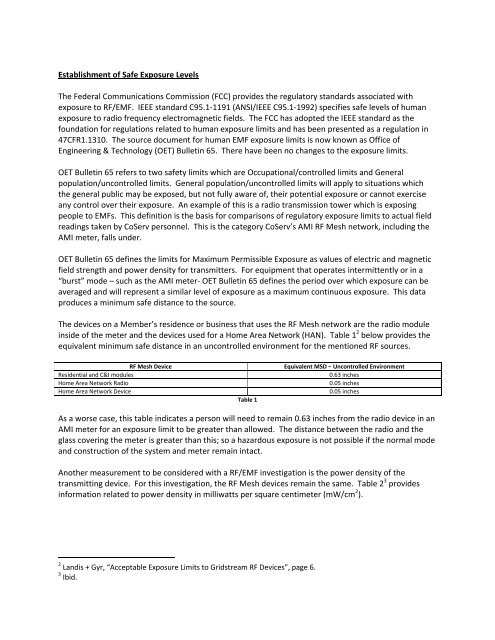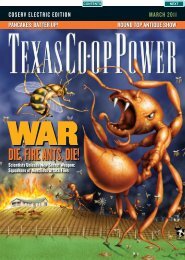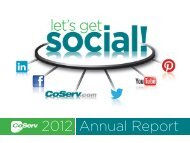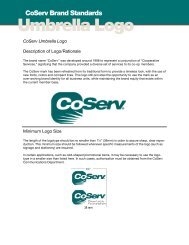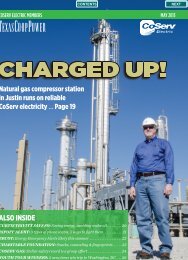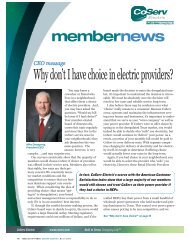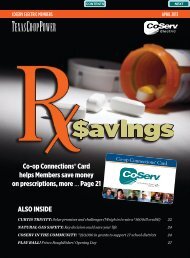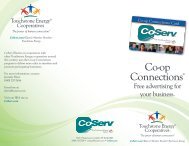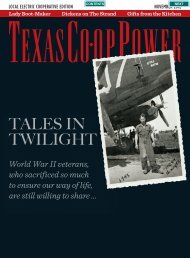Detailed Radio Frequency - CoServ.com
Detailed Radio Frequency - CoServ.com
Detailed Radio Frequency - CoServ.com
You also want an ePaper? Increase the reach of your titles
YUMPU automatically turns print PDFs into web optimized ePapers that Google loves.
Establishment of Safe Exposure Levels<br />
The Federal Communications Commission (FCC) provides the regulatory standards associated with<br />
exposure to RF/EMF. IEEE standard C95.1-1191 (ANSI/IEEE C95.1-1992) specifies safe levels of human<br />
exposure to radio frequency electromagnetic fields. The FCC has adopted the IEEE standard as the<br />
foundation for regulations related to human exposure limits and has been presented as a regulation in<br />
47CFR1.1310. The source document for human EMF exposure limits is now known as Office of<br />
Engineering & Technology (OET) Bulletin 65. There have been no changes to the exposure limits.<br />
OET Bulletin 65 refers to two safety limits which are Occupational/controlled limits and General<br />
population/uncontrolled limits. General population/uncontrolled limits will apply to situations which<br />
the general public may be exposed, but not fully aware of, their potential exposure or cannot exercise<br />
any control over their exposure. An example of this is a radio transmission tower which is exposing<br />
people to EMFs. This definition is the basis for <strong>com</strong>parisons of regulatory exposure limits to actual field<br />
readings taken by <strong>CoServ</strong> personnel. This is the category <strong>CoServ</strong>’s AMI RF Mesh network, including the<br />
AMI meter, falls under.<br />
OET Bulletin 65 defines the limits for Maximum Permissible Exposure as values of electric and magnetic<br />
field strength and power density for transmitters. For equipment that operates intermittently or in a<br />
“burst” mode – such as the AMI meter- OET Bulletin 65 defines the period over which exposure can be<br />
averaged and will represent a similar level of exposure as a maximum continuous exposure. This data<br />
produces a minimum safe distance to the source.<br />
The devices on a Member’s residence or business that uses the RF Mesh network are the radio module<br />
inside of the meter and the devices used for a Home Area Network (HAN). Table 1 2 below provides the<br />
equivalent minimum safe distance in an uncontrolled environment for the mentioned RF sources.<br />
RF Mesh Device<br />
Residential and C&I modules<br />
Home Area Network <strong>Radio</strong><br />
Home Area Network Device<br />
Table 1<br />
Equivalent MSD – Uncontrolled Environment<br />
0.63 inches<br />
0.05 inches<br />
0.05 inches<br />
As a worse case, this table indicates a person will need to remain 0.63 inches from the radio device in an<br />
AMI meter for an exposure limit to be greater than allowed. The distance between the radio and the<br />
glass covering the meter is greater than this; so a hazardous exposure is not possible if the normal mode<br />
and construction of the system and meter remain intact.<br />
Another measurement to be considered with a RF/EMF investigation is the power density of the<br />
transmitting device. For this investigation, the RF Mesh devices remain the same. Table 2 3 provides<br />
information related to power density in milliwatts per square centimeter (mW/cm 2 ).<br />
2 Landis + Gyr, “Acceptable Exposure Limits to Gridstream RF Devices”, page 6.<br />
3 Ibid.


